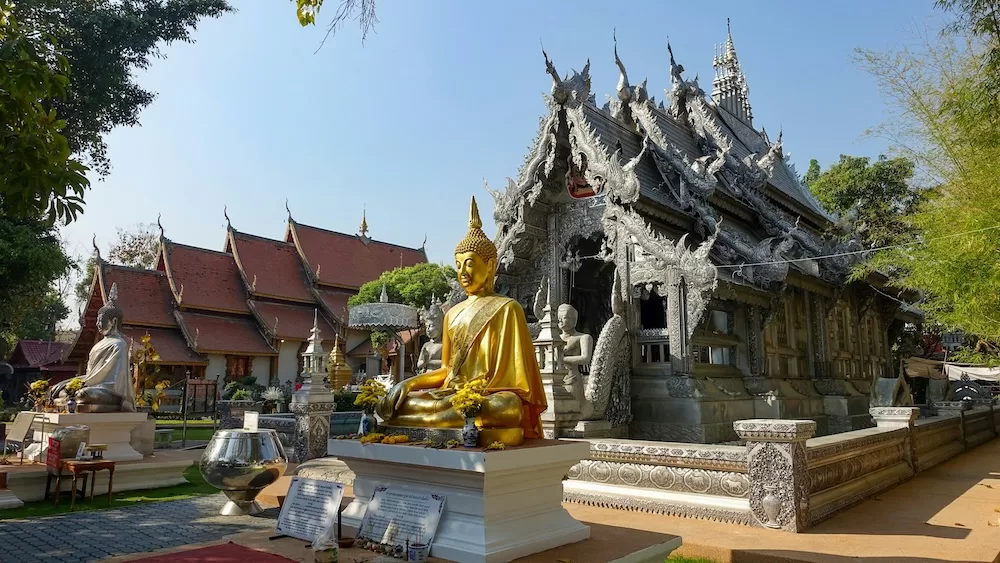
2024 Ultimate 2-Week Itinerary For Cambodia
Cambodia – For Curious Travellers
Cambodia has to be one of the most impressive countries in the world, with beautiful beaches, stunning countryside, and wonderful people. Cambodia is an incredible country to explore, with fascinating cities, delicious food and friendly locals.
Cambodia is most famous for the ancient Khmer Rouge ruins – Angkor Wat – but these magnificent ruins are not the only reason to visit this Southeast Asian nation. Beautiful beaches, lush jungles, rare wildlife, interesting cities and culture, and of course the world-famous temples. For us, the biggest surprise was the cuisine, no one really talks about it but it’s delicious.
How To Get Around Cambodia
The best way to travel around Cambodia is by using the tourist buses and shuttles that are set up in the country. Minivans are frequent, well-connected to the major cities in the country and are very affordable. 12Go is the main booking service that we use to book our buses, trains, ferries and shuttles across Southeast Asia and Cambodia. They are convenient and reliable. Expect that at some point your journey will be uncomfortable, it comes with the experience.
For shorter transport we always use Local Ride-sharing apps like Grab, Be and GoJek.
Best 14 Day Cambodia Itinerary
- Cambodia – For Curious Travellers
- How To Get Around Cambodia
- Important Travel Tips For Cambodia
- Staying Safe and Healthy in Cambodia
- Best 14-Day Cambodia Itinerary
- Siem Reap – Cambodia’s Gateway to Temples – Day 3 – 5
- Battambang – Cambodia’s Most Underrated City – Day 6 & 7
- Kep – Escaping the Crowds – Day 8
- Koh Rong – Cambodia’s Most Popular Island – Day 9 & 10
- Koh Rong Sanloem Island – Cambodia’s Best Relaxing Beach – Day 11 & 12
- Kampot – Cambodia’s Riverside City – Day 13
- Phnom Penh – Day 15
- Essential Travel Toolkit
You can fly between the main cities in Cambodia, however, we decided to take the slow route and travel around Cambodia by bus and train. We made this decision for two reasons:
- Firstly, it offers a great insight into daily life. We wanted to see more of the country and to pass through those small towns, villages and farmlands.
- Secondly, we weren’t worried about splashing a little cash, but we wanted to do that on other experiences. Taking the bus instead of a flight makes it much, much cheaper.
The downside, of course, is the time it takes. Most internal Cambodian flights take 1-2 hours, whereas the buses take 6 – 8 on most routes. Saying that, we were happy to take this time to relax, look out the window and enjoy the scenery.
Tip – Find Transport – Buses, Trains and Planes
In all our travels around South East Asia, when we need to organise longer journeys between regions, capitals and countries, we have generally used 12Go to assess the options. They have a handy feature, which allows you to check the options and manage your travel bookings to get you from place to place on one page.
Important Travel Tips For Cambodia
Train Travel in Cambodia
In Cambodia, there is a small train network, which has undergone some redevelopment in recent times, the vision is that its network forms part of the trans-Asian rail network, for now, these are the main routes:
- Between Phnom Penh and Sihanoukville
- Phnom Penh to Sihanoukville – Once daily
- Trains from Sihanoukville to Phnom Penh – Once daily
- Between Phnom Penh and Poipet
- Phnom Penh to Poipet services currently terminates in Battambang – Once daily
- No services between Poipet and Battambang. Train services from Battambang to Poipet operate once a day every day.
- Phnom Penh to Airport – Not Operating – Book a taxi or airport transfer via 12Go
Between Phnom Penh and Sihanoukville. We recommend travelling this route by train, simply to experience the journey. It’s slower than the bus, however, it’s far more enjoyable and we found it pretty comfortable, the seats are surprisingly roomy, if not a little firm, be prepared though, there is no aircon, but the windows open.
As you depart central station, you pass through the suburbs of Phnom Penh, before moving into open fields and farmland. The train also stops in Takeo and Kampot, before reaching its final destination. Trains currently run once a day from Phnom Penh to Sihanoukville on Fri, Sat and Sun, and on Sat and Sun (twice) in the opposite direction; the full route takes around 7hr.
Side Note: Norry – Bamboo Railway in Battambang
If you don’t want to spend time on the train, a more unique or should I say possibly equally unique option is to check out the Norry – Bamboo Railway in Battambang. Take a trip on the quirky bamboo railway in Battambang also known as Norry, when you get to Battambang.
Bus Travel in Cambodia
Buses are the cheapest – and also usually the most convenient – way of getting around Cambodia, connecting all major cities and towns. All buses are privately run, and operated by a growing number of companies. Mekong Express and Virak Buntham are two of the largest, whilst Giant Ibis and Thero Express run a more modern service. Giant Ibis has the best safety record and operates a service between Phnom Penh and Siem Reap. Rith Mony and Angkor Express both have bad safety records and should be avoided. In terms of service, most buses have A/C and will stop at a rest station along the route. Make sure you don’t wander too far, or the driver will leave without you!
TIP! To Avoid Scams. Always use a booking service or ride-share app, find out about travel scams and ride-share apps.
Buses generally arrive and depart from their respective company offices. Unfortunately, this means that there are no central bus stations or suchlike at which to get centralised consolidated travel information about timetables and fares for Cambodia, which is precisely why ride-share and booking apps such as Grab and GoJek exist. Buses generally arrive and depart from their respective company offices.
Minibuses, which leave from local transport stops, provide the main alternative to buses, at a similar price. These generally serve the same routes as buses, and also run some routes and go to some destinations not served by bus.
Visa for Cambodia
To enter Cambodia as a foreign visitor, a valid passport is a must. Your passport should be valid for at least six months beyond your intended departure date. Visitors to Cambodia must obtain a visa unless they are citizens of one of the visa-exempt countries.
There is an electronic visa, which you can apply for depending on the port of entry, through which you enter the country. The Cambodia e-Visa is available to citizens of all countries worldwide. This visa can only be applied for online. It is a single-entry visa, valid for 30 days from the date of entry into Cambodia. It has a validity of 3 months, starting from the date of issue, for you to commence your stay.
The E-Visa can only be used at the following points of entry
By Air
- Phnom Penh International Airport.
- Siem Reap International Airport.
- Preah Sihanouk International Airport.
By Land
- Cham Yeam (Koh Kong) – via Thailand.
- Poi Pet (Banteay Meanchey) – through Thailand.
- Bavet (Svay Rieng) – through Vietnam.
- Dong Tropaeng Kreal Border Post, (Stung Treng) – through Laos.
Additionally, Cambodia has implemented an electronic Arrival Card. If you’re flying into Cambodia, you must complete and submit the Cambodia e-Arrival Card within 7 days before arrival
Staying Safe and Healthy in Cambodia
Cambodia currently suffers from Insect-borne diseases such as Dengue, Chikungunya, Japanese Encephalitis, and Malaria. The best way to combat an infection is to use insect repellent, wear appropriate clothing, and ensure your accommodation is insect-proof – asking for a mosquito net if required.
Malaria is a risk throughout the year all through Cambodia except in Phnom Penh, Angkor Wat, Siem Reap and close to Tonle Sap. The risk of Malaria is highest in the northeast regions of Preah Vihear, Stung Treng, Ratanakiri and Mondulkiri. If you plan to travel to Cambodia for longer than a 2-week trip, consider taking anti-malarial medication and getting pre-travel vaccinations for Japanese encephalitis, particularly when travelling to remote areas.
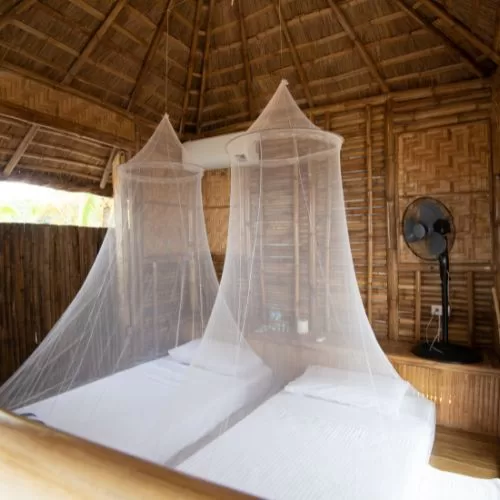
Cambodian animals are carriers of rabies. Rabies is fatal without immediate treatment. A Rabies vaccination before travelling to Cambodia is something you should consider. However, if an animal scratches or bites you, even if you have received the pre-travel vaccination, get medical attention straight away.
Outbreaks of hand, foot and mouth disease are common in Cambodia. Other food-borne, waterborne, parasitic and infectious diseases include hepatitis, tuberculosis and typhoid. Drink only boiled or bottled water, and avoid raw or undercooked food. Another point to remember is to not swim in freshwater due to the risk of Schistosomiasis (also known as bilharzia), a parasitic infection that is transmitted to humans through contact with fresh water.
Best 14-Day Cambodia Itinerary

Phnom Penh – Cambodia’s Capital – Day 1 & 2

Most travellers pass through Phnom Penh on their way in or out of the country. Top sights not to miss in Phnom Penh include the Royal Palace, with its intricate architecture, and the nearby Silver Pagoda. Phnom Penh is the capital of Cambodia and with a population of about 2.3 million, it is busy and bustling and there are plenty of options for what to do in Phnom Penh. The city sits where the Mekong, Bassac, and Tonlé Sap rivers meet. The solemn yet essential Tuol Sleng Genocide Museum and the Killing Fields are not to miss places, they provide a small glimpse into the country’s recent past. Wander through the Central and Russian Markets to immerse yourself in the local life and flavours. Unless you’re flying in and out of Siem Reap, it’s inescapable. All roads lead to Phnom Penh – quite literally. If you’re planning to travel around Cambodia, logistics will compel you to set foot in the capital at least once or twice.
Where To Stay In Phnom Peng
The Riverfront District is the best neighbourhood in Phnom Penh to stay in if you’re visiting for the first time. Phnom Penh’s Riverside is part of Khan Doun Penh, a large district that stretches along the Tonlé Sap from the Japanese Bridge all the way to the Independence Monument. This area is also home to popular and renowned landmarks and attractions, including Wat Ounolom, the National Museum and the Central Market. This vibrant riverfront area is home to an excellent selection of restaurants, shops and bars that will entertain travellers of all ages, interests and budgets. This area is walking distance from all the main attractions but a touch quieter and less touristy which makes it the best area to stay in Phnom Penh for first-time visitors. You can find some great budget accommodations here as well as several highly rated resorts. However, it’s important to know that it’s not the safest at night.
Want to find out more about Phnom Peng – What to see and Where to stay read our full guide here.
Siem Reap – Cambodia’s Gateway to Temples – Day 3 – 5
The main reason most people travel to Siem Reap is the former capital of the Khmer Empire, Angkor. Now a labyrinth of temples and a favourite of tourists to explore. However, what you need to remember when visiting is that Siem Reap has far more to offer than Angkor Wat alone. Siem Reap is home to distinctive architecture, Khmer culture, and the most magnificent temples in Cambodia. From Siem Reap, you can explore numerous temples, including Bayon Temple, Ta Prohm, and Banteay Srei. Once you have explored Angkor Wat, done the Angkor Wat sunrise, along with every other tourist in Siem Reap, take the time to explore Siem Reap and see some of the other temples that are a bit further away.
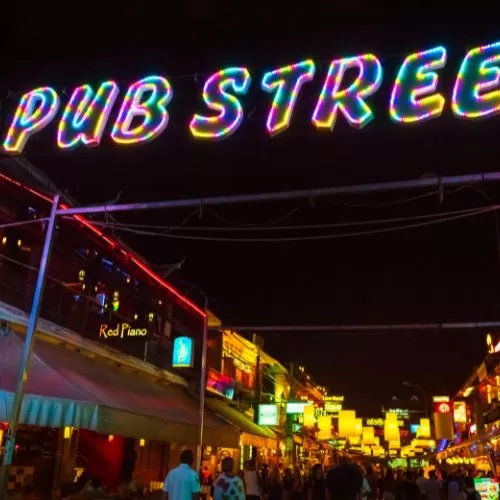
Where To Stay In Siem Reap
There are many places to stay in Siem Reap catering to all budgets and travel styles. Siem Reap is also a great destination if you are travelling on a budget. And if you aren’t travelling on a budget, you’re stoked because you get luxury hotels for a fraction of the price. The best place to stay for first-timers is the Old French Quarter. The Old French Quarter can be found west of the Siem Reap River that runs through town. There are numerous shops, restaurants and cafes and you can easily spend the morning shopping and eating your way through the French Quarter. Laid out like a grid it’s easy to navigate and wander in and out of the narrow streets. The area has a lot of charm and is full of colonial buildings and French architecture. Here you’ll find the city’s top attractions such as the grand Royal Residence and Royal Gardens. However, the Old French Quarter is pretty popular! Since it’s set right in the centre of Siem Reap, everyone wants to stay here, which means that hotels are booked up fast.
Top Tip: When deciding where to stay in Siem Reap, make sure to find accommodation with a pool. You’ll be happy to relax by the pool after a day of temple hopping in the hot sun.
Want to find out more about Siem Reap and the temples beyond Angkor Wat read our full guide here.
Battambang – Cambodia’s Most Underrated City – Day 6 & 7
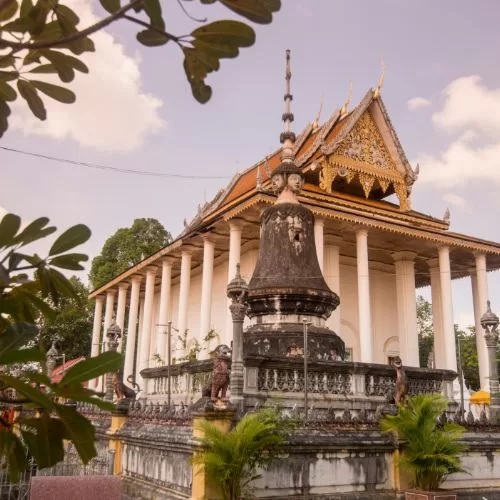
Battambang is often overlooked. It lacks the obvious Cambodian trump cards: no golden beaches, no capital city buzz, and no Angkor Wat. But then neither does it suffer from congested traffic, coach loads of tourists, or hordes of touts. In fact, Cambodia’s second-largest city is one in perfect balance – it’s bustling yet friendly and interesting without being overwhelming. What we loved about Battambang is that it wasn’t a hard place to get to know well. It’s a large city by the standards of the country, but it isn’t overwhelming, and that lends itself to both an intimate and manageable visit. Here you can experience quirky attractions such as the bamboo railway, where People, rice and livestock are shuttled back and forth upon squat wooden platforms, which are placed on top of a wheeled metal carriage powered by a small engine. Or better yet, try your hand at making authentic Khmer dishes, Local restaurant Smokin’ Pot run cookery courses. Owner and chef Vannak runs popular three-hour classes every morning, kicking off with a trip to the local market and finishing with a hard-earned lunch.
Where To Stay Krong Battambang
Battambang has become increasingly popular in recent years, however, compared to other Cambodian destinations it remains relatively under-visited. The increase in traveller numbers has led to a range of places to stay cropping up, with options to suit any visitor and budget. Where to stay in Battambang depends on what kind of holiday you want. If you want to get away from it all, there are beautiful boutique hotels in colonial-style mansions and atmospheric wooden houses with stunning pools. If you want something cheap and cheerful, you’ll find that too in no-frills city centre hotels. The bustling market, coffee shops and best restaurants are all based on the river’s west bank in the city centre, and this is where several of the most popular hotels are based.
Kep – Escaping the Crowds – Day 8
Kep is an ideal place to escape from crowds that are slowly taking over Cambodian beaches. Kep is quiet – but is developing slowly as more visitors go there – and makes for the perfect place to relax and dine out on freshly caught seafood, in particular crab. The main public beach is a wide sandy cove, popular with tourists and locals alike. It’s also definitely worth visiting the beautiful national park though be warned – if you want to hike in Kep National Park you will still get sweaty! Meander along the long promenade overlooking the sea, stopping for snacks along the way. There are a range of places to chill in a hammock and watch the world go by while you enjoy your favourite tipple.
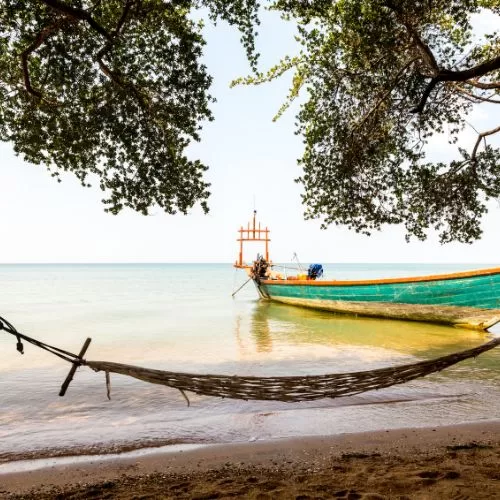
Where To Stay In Kep
Despite Kep being quiet, there are a whole load of accommodation options to choose from, ranging from budget to high-end. While most choose to stay in the middle of the city due to its proximity to the Crab Market and the abandoned mansions, there is also the option of staying a little further out, close to Kep National Park. Bear in mind that if you are on the main road which connects Kampot to Kep, it could be as much as a half-hour walk to the Crab Market.
Koh Rong – Cambodia’s Most Popular Island – Day 9 & 10
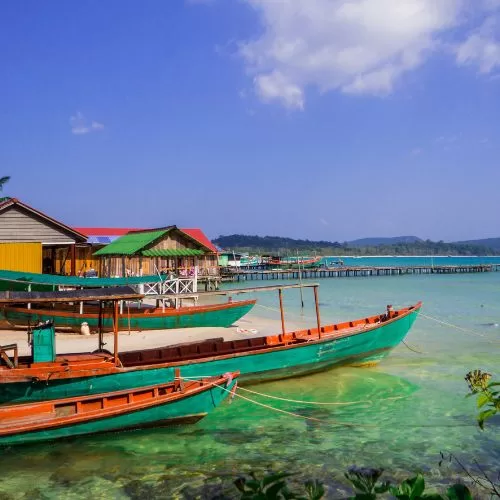
Koh Rong is famous for its serene beauty. Often described as an ‘island paradise’ by visiting tourists, the island boasts pristine white sandy beaches, warm crystal-clear ocean waters, and a hot tropical climate. Bungalows on the beach, countless hammocks and wooden swings line the gulf. The mixture of beaches, jungles and tropical weather, alongside a small island vibe, is a match made in heaven. The water off Koh Rong is one of the few places in Asia where you can swim with bioluminescent plankton, that glow when disturbed. In the heart of Koh Rong is a thick mangrove forest, with a winding river you can kayak all the way to the ocean.
Where to Stay on Koh Rong
While not a huge island, Koh Rong can be tricky to navigate due to a lack of roads so it’s important to pick carefully where to stay. There are a few different areas to stay when choosing hotels in Koh Rong. You can stay in town which is the first ferry stop or you can stay at a nicer resort in Koh Rong which will more than likely be the second stop on the ferry. Kaoh Touch Beach or the bottom of Long Set Beach are great areas to stay on the island as they are within walking distance of the main area of restaurants and bars. We stayed in Koh Touch Village the first night and switched to a nicer resort for the remainder of our stay. It was an easy way to get our bearings after a long day of travel on the first day. Here are a few options on where to stay in town on Koh Rong Island.
Koh Rong Sanloem Island – Cambodia’s Best Relaxing Beach – Day 11 & 12
Next door to Koh Rong you will find its sister island called Koh Rong Samloem. It may be smaller but I can promise you it is equally as incredible! This island paradise is known for its white sandy beaches, warm crystal waters and exquisite underwater life, including the magnificent glowing bioluminescent plankton. The island is a great place to enjoy the pristine beaches, and activities such as snorkelling, diving and kayaking. Do some jungle hiking and look for the best views that Koh Rong Samloem has to offer, set off on the trail towards the old lighthouse. Look out for the fantastic waterfall close to Saracen Bay’s main pier and Freedom Island Resort. It’s surrounded by tropical green jungle and you can sit in the refreshing water at the bottom to cool off on a hot day… very inviting! Take advantage of the amazing underwater life at Cambodia’s first Marine National Park with a spot of diving or snorkelling.

Where to Stay on Koh Rong Sanloem
One option is MPai-Bay on the north of the island. The beautiful cove is surrounded by many stunning beaches and accommodation here is the most affordable on the island. There is great nightlife and cheap places to eat and drink nearby. This is the area to stay in if you are a backpacker who wants to meet new people and socialise.
Another option is on the east coast of Koh Rong Sanloem called Saracene Bay. If you are a family or a couple who want better service, a nice hotel room and a classic holiday island experience, then the best place to stay would be here. Also, Saracen Bay is famous for its wide, fine, white sand beach. Saracen Bay is the best place to stay on Koh Rong Samloem for convenience, however, this means it can also get very busy, especially during peak season.
The third option is Sunset Beach. Located on the western side of the island, this area is a favourite among hippies and divers. It’s great for travellers who prefer a quieter setting and a slower pace of life, as well as that classic Southeast Asia hippie vibe. As you’re likely to have gathered from its name, this spot is a fantastic place to catch one of Koh Rong Samloem’s sunsets! Once upon a time, the only way to reach Sunset Beach was by foot on a challenging jungle track. While you can still walk there from Saracen Bay, the journey is now much easier, with roads some of the way and ropes to assist with the descent down the jungle track. However, bear in mind that this route would be difficult to navigate with a suitcase! Boat taxis also go to Sunset Beach from Saracen Bay and M’Pai Bay.
Don’t want to stay in Koh Rong, then read our guide to Cambodia’s Islands and beaches to decide which islands are best for your trip read our full guide here.
Kampot – Cambodia’s Riverside City – Day 13
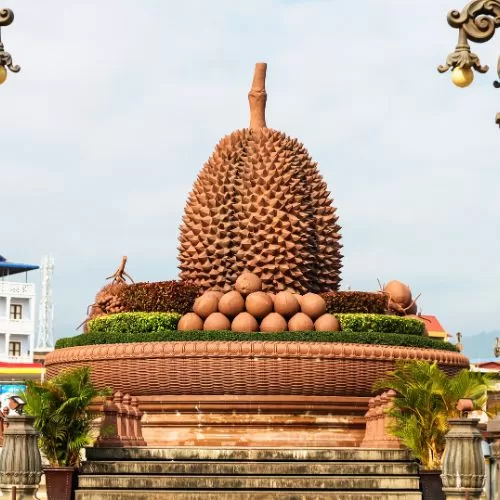
The little town of Kampot is nestled on the banks of the Sangke River, just a few miles from the coast. Kampot’s sleepiness is part of its charm. Traffic is minimal and it’s easy to get around the wide streets on foot, bicycle or motorbike. The backdrop is, for the first time in weeks, hilly – in fact, the range is known as the Elephant Mountains, though they don’t appear to be high enough to warrant that particular title. Kampot’s crowning glory is its riverside with a lovely promenade on one side and a whole fleet of floating restaurants on the other. Dotted along the riverfront on the town side are some better quality eateries, though “international” menu options still prevail alongside the Khmer dishes even here.
Life feels slow here, un-rushed, with hot afternoons meant for lazing in hammocks or swimming in the river.
Where To Stay in Kampot
In town: The central part of Kampot town is on the eastern bank of the river. It’s where you’ll find most cafes, restaurants and bars. I highly recommend staying in town if you plan on eating out a lot. If you want to be right in the thick of it, choose a hotel close to Old Market Street or the Durian Roundabout.
Thvi: Located on the opposite side of the river, the Thvi area is still close to the main centre of town, but it’s a bit quieter. You can find some really nice riverside accommodations north of the bridge, and a few beachfront resorts to the south.
Riverfront North: Most bungalows and riverside accommodation is located outside of town along the northern part of the river. If you’ve come to Kampot to relax, swim or kayak, then this is the place to stay. It’s a bit of a way into town (about a 20-minute tuk-tuk ride), so you’ll probably end up eating most meals at your accommodation. Take this into consideration when booking. Definitely a ‘flop and drop’ location.
Phnom Penh – Day 15
If you have already taken the time to explore Phnom Penh and its temples and museums, then you could spend some time checking out the best cafes in Phnom Penh. While much of Phnom Penh’s history is very sad, there is a happier side, and this can be shown through the other spots of the city.
Most travellers will be moving on from Cambodia, and From Phnom Penh, you have a few options. It’s easy to head into Vietnam from here, either on a sleeper bus to Ho Chi Minh City or a day bus to the Mekong Delta. You can also take a sleeper bus to Bangkok. Or head north, to Pakse in Laos and start a Laos adventure.
Essential Travel Toolkit
🚖 Rideshare Apps – The most complete guide to Rideshare, Ride-hailing and taxis in Southeast Asia.
🚞 12Go.com – The easiest way to book transport, public or private in Southeast Asia, Japan and Beyond.
🏨 Trip.com – Consistently great accommodation and hotel deals.
🛩️ Trip.com – Get the best flight deals.
🚙 Trip.com – Find your perfect rental car.
🗺️ Getyourguide.com – Looking for an amazing local guide or tour. Get Your Guide will have something for everyone.
🗺️ Viator.com – Easily book tours and experiences at the lowest rate. Amazing options all over the world.
👨💻 NordVPN.com – Reliable VPN service that is guaranteed to keep you and your data safe anywhere in the world.
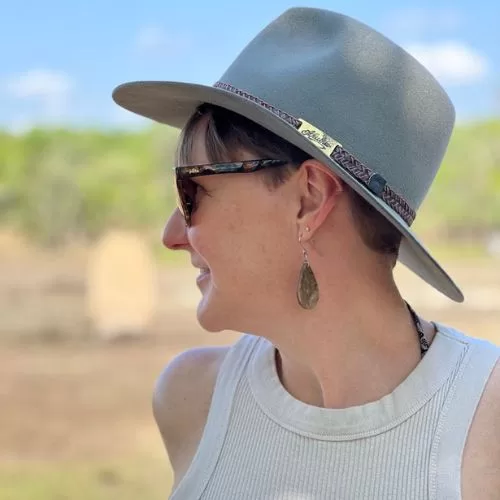
Wendy is a traveller, writer, and photographer with an insatiable curiosity for the world. Her journey, spanning South Africa, the UK, and now Australia, infuses her work with a rich tapestry of experiences. Join her on Getting Lost Again as she shares her creative perspective and passion for overland travel alongside Dan.

